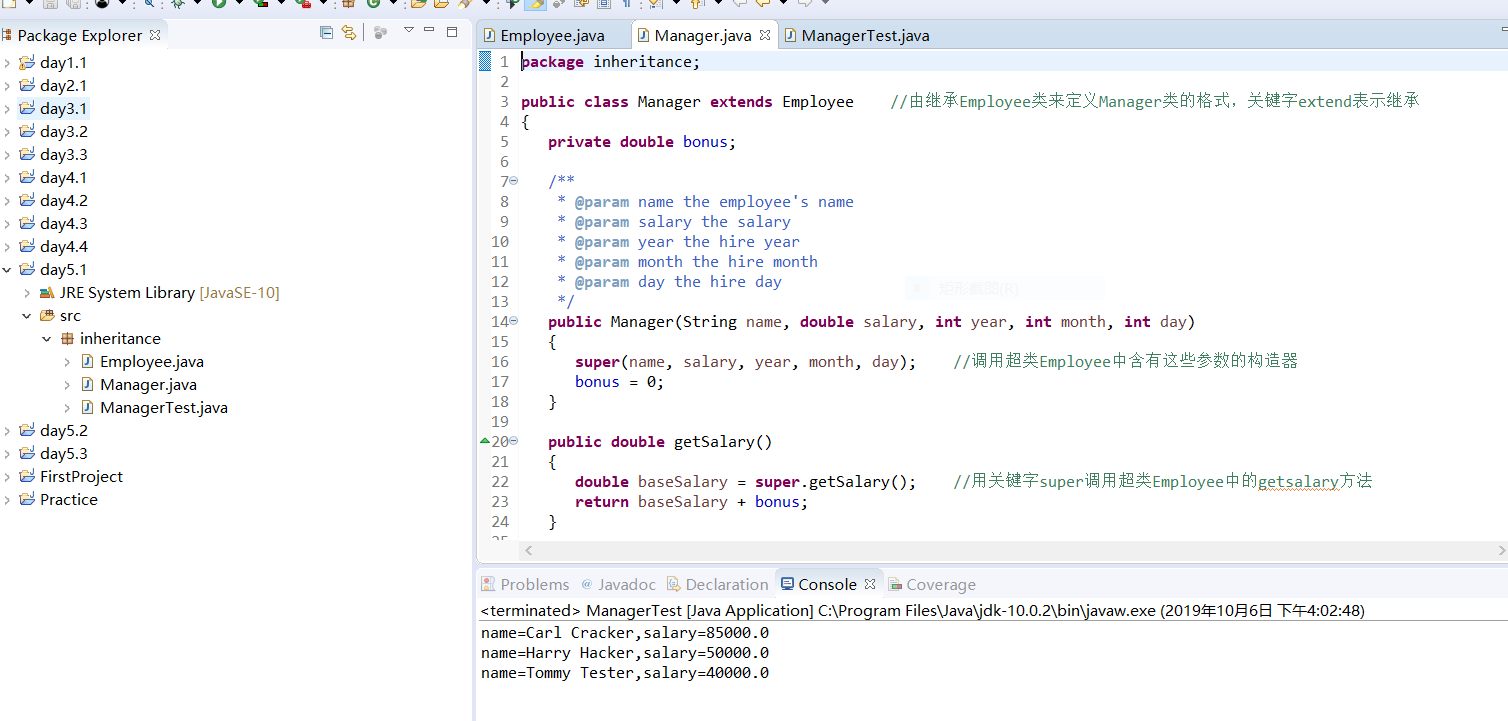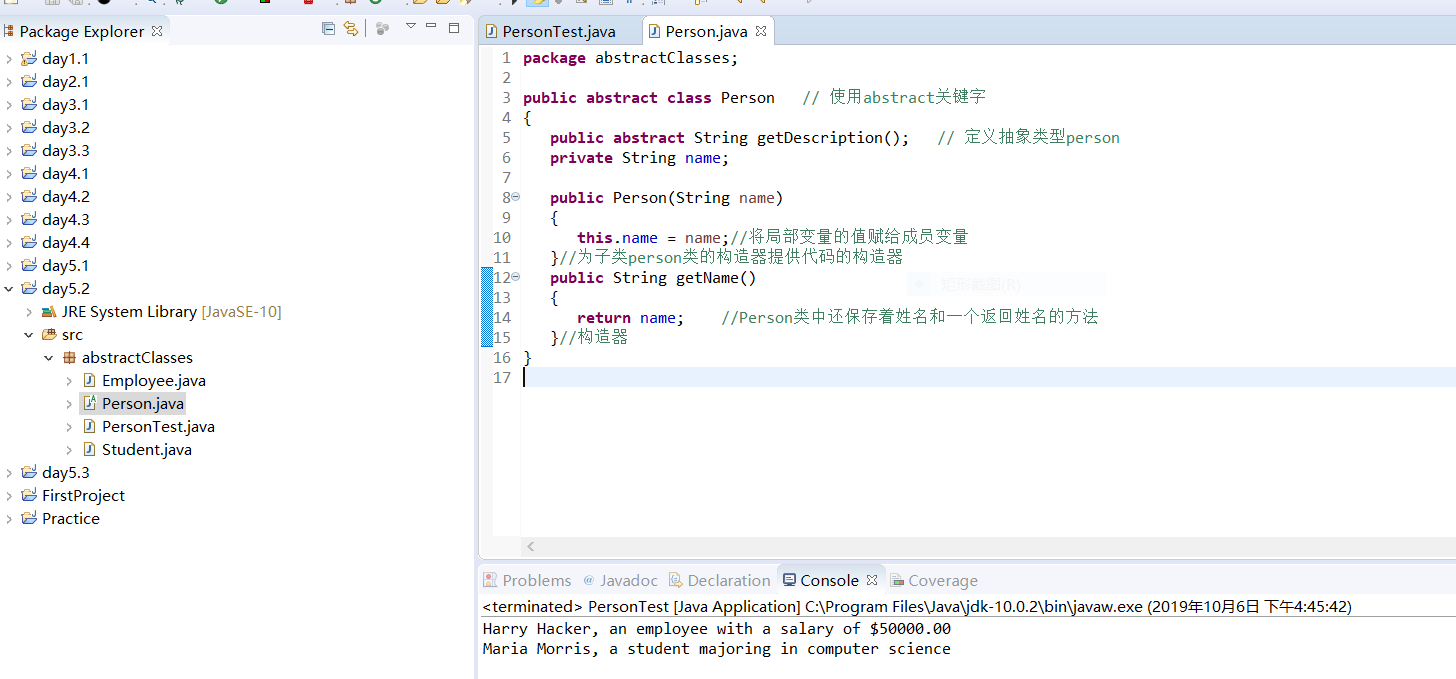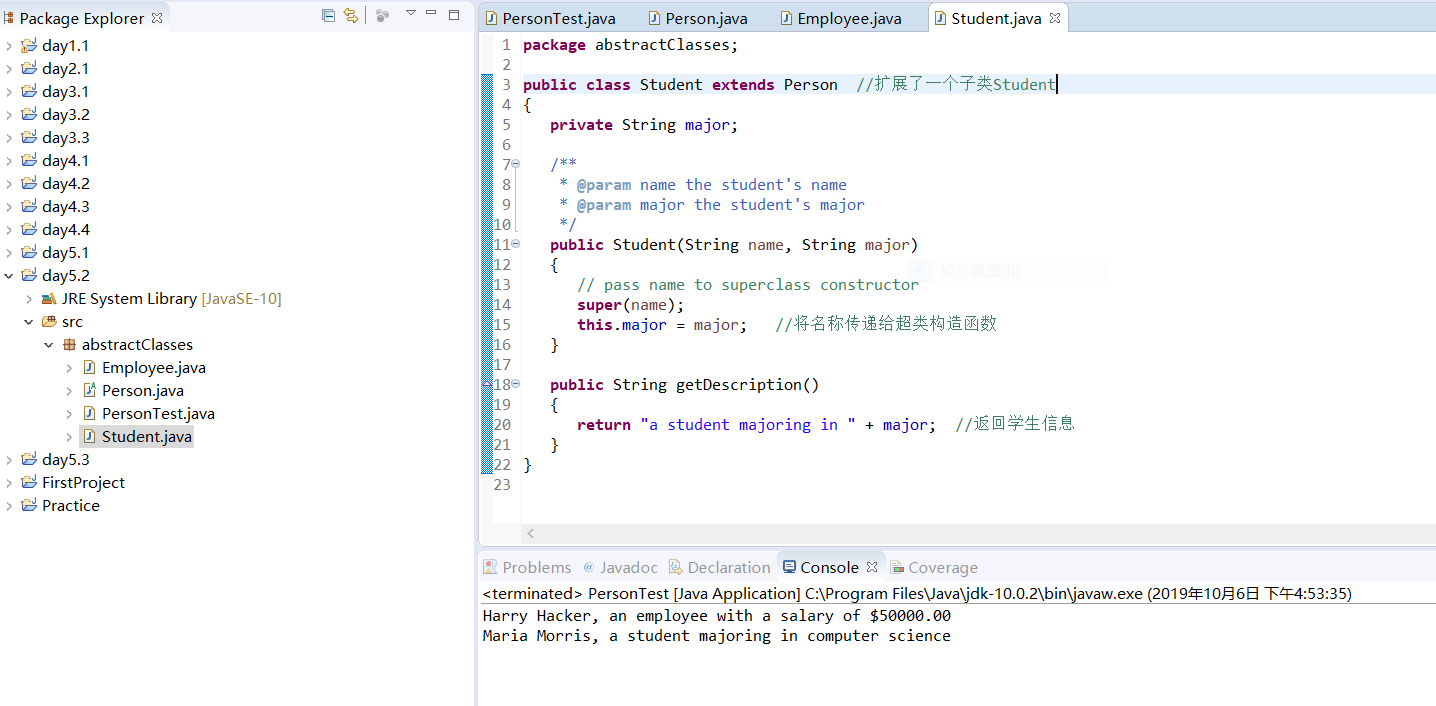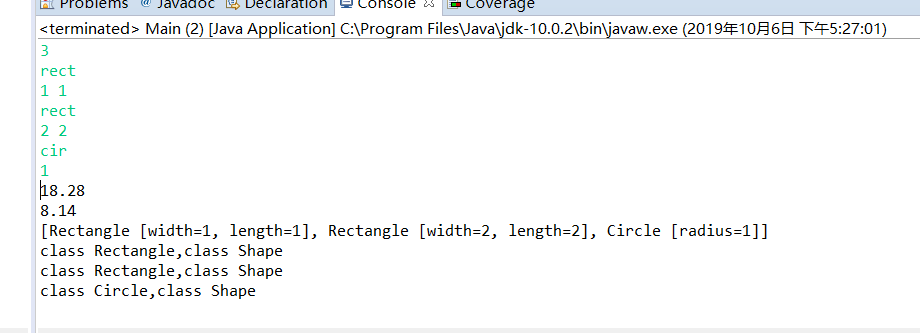|
项目 |
内容 |
|
《面向对象程序设计(java)》 |
https://home.cnblogs.com/u/nwnu-daizh/ |
|
这个作业的要求在哪里 |
https://www.cnblogs.com/nwnu-daizh/p/11605051.html |
|
作业学习目标 |
|
随笔博文正文内容包括:
第一部分:总结第五章理论知识(30分)
一.继承:
用已有的类来构建新类的一种机制。当定义了一个新类继承了一个类时,这个类就继承了这个方法和域,同时在新类中添加新的方法和域以适应新情况。继承时Java程序设计中的一项核心技术,也是面向对象特征之一。
继承的优点:具有层次结构。子类继承父类的域和方法。 代码可重用性。父类的域和方法课用于子类。可以轻松定义子类。设计应用程序变得更加简单。
二.类、超类和子类:
1.定义子类:关键字extends表明正在构造的新类派生于一个已存在的类,已存在的类称为超类、基类或父类;新类称为子类、派生类或孩子类。子类比父类拥有的功能更加丰富。
在通过扩展超类定义子类的时候,仅需要指出子类与超类的不同之处。在设计类的时候,将通用的方法放在超类中,将具有特殊用途的方法放在子类中。
2.覆盖方法:在子类中可以增加域,增加方法或覆盖超类的方法,但绝对不能删除继承的任何域和方法。
3.子类构造器:如果子类的构造器没有显式地调用超类的构造器,则将自动地调用超类默认地构造器,如果超类没有不带参数地构造器,并且在子类的构造器中又没有显式地调用超类地其他构造器,则Java编译器将报告错误。
一个对象变量可以指示多种实际类型的现象被称为多态,在运行时能够自动地选择调用哪个方法地现象称为动态绑定。
this :1.引用隐式传参 2.调用类其他构造器
super:1.调用超类的方法 2.调用超类的构造器
使用super调用基类的方法
子类构造器会默认调用基类的无参构造来初始化基类的私有域,如果基类没有无参构造,则会报错
java中,不需要将方法声明为虚拟方法方法,基类指针指向不同对象时,虚拟指针知道指针指向的实际对象类型,所以能正确调用对应的方法,如果不希望让一个方法具有虚拟特征,可以标记为final
4.继承层次:继承并不仅限于一个层次,由一个公共超类派生出来的所有类的集合被称为继承层次,在继承层次中,从某个特定的类到其祖先的路径被称为该类的继承链。Java不支持多继承。
5.动态绑定、静态绑定和方法表:
编译器准确知道调用哪个方法的叫静态绑定(用private、static、final声明过的方法)
在运行时,调用方法依赖于实际类型并实现方法绑定(运行时可知)的叫动态绑定,虚拟机为基类和派生类生成一个方法表,虚拟机会在方法表中搜索最适合的方法进行调用。
抽象类包含抽象方法也可以包含具体数据、具体方法。
类即时不含有抽象方法,也可以声明为抽象类。
抽象类不能被实例化。
9.受保护访问:
private:本类可见(也是c++初始化列表的原因,因为子类不可方位基类的private字段,需要调用基类的构造函数)
public:对所有类可见
protected:本包和所有子类可见(c++只对子类可见)
默认(无修饰符):对本包可见
Object类是Java中所有类的祖先——每一个类都由它扩 展而来。在不给出超类的情况下,Java会自动把Object 作为要定义类的超类。
可以使用类型为Object的变量指向任意类型的对象。但 要对它们进行专门的操作都要进行类型转换。
equals方法:定义子类的equals方法时,可调用超类的equals方法。 super.equals(otherObject)
hashCode方法:Object类中的hashCode方法导出某个对象的散列 码。散列码是任意整数,表示对象的存储地址。 两个相等对象的散列码相等。
五.对象包装器与自动装箱:
每个基本类型都有之对应的类(对象包装类)
对象包装类不允许修改其中的值,同时也是final声明的
使用包装器声明变量时,其==表示其是否指向同一个对象,因此
两个对象包装器比较时调用equal方法
java 使用持有者类型(IntHolder、BooleanHold等)
可变参数 使用:public static double max(double... value);实际上将若干参数绑定在数组中传递该max函数:public static void main(String... args)。
七.枚举类:
实际上是一个类,包含若干个实例,因此两个枚举类型的值比较,直接使用 == ,永远不要调用equal。
所有的枚举类型都是Enum类的子类。所以他们继承了这个类的许多方法String toString() //返回枚举常量名
static Enum valueOf(Class enumClass,String name)//返回指定名字给定类的枚举常量
int ordinal() //返回在enum声明中枚举常量的索引 (从0 开始)
int compareTo(E other) //在枚举中的顺序比较
八.反射:
反射被大量用在javaBeans中。
反射的作用:
①在运行中分析类的能力
②在运行在查看类的对象
③实现通过的数组操作代码
④利用Method对象。
第二部分:实验部分
1、实验目的与要求
(1) 理解继承的定义;
(2) 掌握子类的定义要求
(3) 掌握多态性的概念及用法;
(4) 掌握抽象类的定义及用途。
2、实验内容和步骤
实验1:测试程序1(10分)
5-1程序代码如下:
|
1
2
3
4
5
6
7
8
9
10
11
12
13
14
15
16
17
18
19
20
21
22
23
24
25
26
27
28
|
package inheritance;/** * This program demonstrates inheritance. * @version 1.21 2004-02-21 * @author Cay Horstmann */public class ManagerTest{ public static void main(String[] args) { // construct a Manager object 构造一个manager对象 var boss = new Manager("Carl Cracker", 80000, 1987, 12, 15); //将经理放到数组中去 boss.setBonus(5000); //由boss.setBonus单独设置津贴,其中setBonus是Manager的特有方法 var staff = new Employee[3]; //定义一个包含三个雇员的数组 // fill the staff array with Manager and Employee objects staff[0] = boss; // 父类可以引用子类 staff[1] = new Employee("Harry Hacker", 50000, 1989, 10, 1); //将经理和雇员都放到数组中去 staff[2] = new Employee("Tommy Tester", 40000, 1990, 3, 15); // print out information about all Employee objects for (Employee e : staff) //for循环打印出各个雇员对象的信息 System.out.println("name=" + e.getName() + ",salary=" + e.getSalary()); }} |
运行结果如下:

5-2程序代码如下:
|
1
2
3
4
5
6
7
8
9
10
11
12
13
14
15
16
17
18
19
20
21
22
23
24
25
26
27
28
29
30
31
32
33
34
35
36
37
38
|
package inheritance;import java.time.*;public class Employee{ private String name;//private定义了一个只能在该类中访问的字符串常量 private double salary; private LocalDate hireDay; public Employee(String name, double salary, int year, int month, int day)//定义变量 { this.name = name;//将局部变量的值传递给成员变量 this.salary = salary; hireDay = LocalDate.of(year, month, day); }//一个构造器,构造器与类同名 public String getName() { return name; }//访问器 public double getSalary() { return salary; }//访问器 public LocalDate getHireDay() { return hireDay; }//访问器 public void raiseSalary(double byPercent) { double raise = salary * byPercent / 100; salary += raise; }} |
程序运行结果如下:

5-3程序代码如下:
|
1
2
3
4
5
6
7
8
9
10
11
12
13
14
15
16
17
18
19
20
21
22
23
24
25
26
27
28
29
30
|
package inheritance;public class Manager extends Employee //由继承Employee类来定义Manager类的格式,关键字extend表示继承{ private double bonus; /** * @param name the employee's name * @param salary the salary * @param year the hire year * @param month the hire month * @param day the hire day */ public Manager(String name, double salary, int year, int month, int day) { super(name, salary, year, month, day); //调用超类Employee中含有这些参数的构造器 bonus = 0; } public double getSalary() { double baseSalary = super.getSalary(); //用关键字super调用超类Employee中的getsalary方法 return baseSalary + bonus; } public void setBonus(double b) { bonus = b; }} |
程序运行结果如下:

删除程序中Manager类、ManagerTest类,背录删除类的程序代码,在代码录入中理解父类与子类的关系和使用特点。
删除Manager类程序代码如下:
|
1
2
3
4
5
6
7
8
9
10
11
12
13
14
15
16
17
18
19
20
21
22
23
24
25
26
27
28
29
30
|
package inheritance;public class Manager extends Employee //由继承Employee类来定义Manager类的格式,关键字extend表示继承{ private double bonus; /** * @param name the employee's name * @param salary the salary * @param year the hire year * @param month the hire month * @param day the hire day */ public Manager(String name, double salary, int year, int month, int day) { super(name, salary, year, month, day); //调用超类Employee中含有这些参数的构造器 bonus = 0; } @Override public double getSalary() { double baseSalary = super.getSalary(); //用关键字super调用超类Employee中的getsalary方法 return baseSalary + bonus; } public void setBonus(double b) { bonus = b; }} |
删除ManagerTest类程序代码如下:
|
1
2
3
4
5
6
7
8
9
10
11
12
13
14
15
16
17
18
19
20
21
22
23
24
25
26
27
28
|
package inheritance;/** * This program demonstrates inheritance. * @version 1.21 2004-02-21 * @author Cay Horstmann */public class ManagerTest{ public static void main(String[] args) { // construct a Manager object 构造一个manager对象 var boss = new Manager("Carl Cracker", 80000, 1987, 12, 15); //将经理放到数组中去 boss.setBonus(5000); //由boss.setBonus单独设置津贴,其中setBonus是Manager的特有方法 var staff = new Employee[3]; //定义一个包含三个雇员的数组 // fill the staff array with Manager and Employee objects staff[0] = boss; // 父类可以引用子类 staff[1] = new Employee("Harry Hacker", 50000, 1989, 10, 1); //将经理和雇员都放到数组中去 staff[2] = new Employee("Tommy Tester", 40000, 1990, 3, 15); // print out information about all Employee objects for (Employee e : staff) //for循环打印出各个雇员对象的信息 System.out.println("name=" + e.getName() + ",salary=" + e.getSalary()); }} |
程序运行结果如下:

实验1:测试程序2(10分)
5-4程序代码如下:
|
1
2
3
4
5
6
7
8
9
10
11
12
13
14
15
16
17
18
19
20
21
22
|
package abstractClasses;/** * This program demonstrates abstract classes. * @version 1.01 2004-02-21 * @author Cay Horstmann */public class PersonTest{ public static void main(String[] args) { var people = new Person[2]; //定义一个包含2个雇员的数组 // fill the people array with Student and Employee objects people[0] = new Employee("Harry Hacker", 50000, 1989, 10, 1); people[1] = new Student("Maria Morris", "computer science"); //将雇员和学生的对象填充到Person引用数组 // print out names and descriptions of all Person objects for (Person p : people) System.out.println(p.getName() + ", " + p.getDescription()); // 输出对象的姓名和信息描述 }} |
程序运行结果如下:

5-5程序代码如下:
|
1
2
3
4
5
6
7
8
9
10
11
12
13
14
15
16
|
package abstractClasses;public abstract class Person // 使用abstract关键字{ public abstract String getDescription(); // 定义抽象类型person private String name; public Person(String name) { this.name = name;//将局部变量的值赋给成员变量 }//为子类person类的构造器提供代码的构造器 public String getName() { return name; //Person类中还保存着姓名和一个返回姓名的方法 }//构造器} |
程序运行结果如下:

5-6程序代码如下:
|
1
2
3
4
5
6
7
8
9
10
11
12
13
14
15
16
17
18
19
20
21
22
23
24
25
26
27
28
29
30
31
32
33
34
35
36
37
|
package abstractClasses;import java.time.*;public class Employee extends Person //扩展了一个子类Person{ private double salary; private LocalDate hireDay; public Employee(String name, double salary, int year, int month, int day)//定义变量 { super(name); this.salary = salary; hireDay = LocalDate.of(year, month, day);//hireday使用LocalDate的方法 } public double getSalary() { return salary; } public LocalDate getHireDay() { return hireDay; } public String getDescription() { return String.format("an employee with a salary of $%.2f", salary); } public void raiseSalary(double byPercent) { double raise = salary * byPercent / 100; salary += raise; }} |
程序运行结果如下:

5-7程序代码如下:
|
1
2
3
4
5
6
7
8
9
10
11
12
13
14
15
16
17
18
19
20
21
22
|
package abstractClasses;public class Student extends Person //扩展了一个子类Student{ private String major; /** * @param name the student's name * @param major the student's major */ public Student(String name, String major) { // pass name to superclass constructor super(name); this.major = major; //将名称传递给超类构造函数 } public String getDescription() { return "a student majoring in " + major; //返回学生信息 }} |
程序运行结果如下:

删除程序中Person类,PerTest类,背景录入删除类的程序代码,在代码录入中理解抽象类与子类的关系和使用特点。
删除Person类程序代码如下:
|
1
2
3
4
5
6
7
8
9
10
11
12
13
14
15
16
|
package abstractClasses;public abstract class Person // 使用abstract关键字{ public abstract String getDescription(); // 定义抽象类型person private String name; public Person(String name) { this.name = name;//将局部变量的值赋给成员变量 }//为子类person类的构造器提供代码的构造器 public String getName() { return name; //Person类中还保存着姓名和一个返回姓名的方法 }//构造器} |
删除PersonTest类程序代码如下:
|
1
2
3
4
5
6
7
8
9
10
11
12
13
14
15
16
17
18
19
20
21
22
|
package abstractClasses;/** * This program demonstrates abstract classes. * @version 1.01 2004-02-21 * @author Cay Horstmann */public class PersonTest{ public static void main(String[] args) { var people = new Person[2]; //定义一个包含2个雇员的数组 // fill the people array with Student and Employee objects people[0] = new Employee("Harry Hacker", 50000, 1989, 10, 1); people[1] = new Student("Maria Morris", "computer science"); //将雇员和学生的对象填充到Person引用数组 // print out names and descriptions of all Person objects for (Person p : people) System.out.println(p.getName() + ", " + p.getDescription()); // 输出对象的姓名和信息描述 }} |
程序运行结果如下:

实验1:测试程序3(11分)
5-8程序代码如下:
|
1
2
3
4
5
6
7
8
9
10
11
12
13
14
15
16
17
18
19
20
21
22
23
24
25
26
27
28
29
30
31
32
33
34
35
36
37
|
package equals;/** * This program demonstrates the equals method. * @version 1.12 2012-01-26 * @author Cay Horstmann */public class EqualsTest{ public static void main(String[] args) { var alice1 = new Employee("Alice Adams", 75000, 1987, 12, 15); var alice2 = alice1; var alice3 = new Employee("Alice Adams", 75000, 1987, 12, 15); var bob = new Employee("Bob Brandson", 50000, 1989, 10, 1); System.out.println("alice1 == alice2: " + (alice1 == alice2)); System.out.println("alice1 == alice3: " + (alice1 == alice3)); System.out.println("alice1.equals(alice3): " + alice1.equals(alice3)); System.out.println("alice1.equals(bob): " + alice1.equals(bob)); System.out.println("bob.toString(): " + bob); var carl = new Manager("Carl Cracker", 80000, 1987, 12, 15); var boss = new Manager("Carl Cracker", 80000, 1987, 12, 15); boss.setBonus(5000); System.out.println("boss.toString(): " + boss); System.out.println("carl.equals(boss): " + carl.equals(boss)); System.out.println("alice1.hashCode(): " + alice1.hashCode()); System.out.println("alice3.hashCode(): " + alice3.hashCode()); System.out.println("bob.hashCode(): " + bob.hashCode()); System.out.println("carl.hashCode(): " + carl.hashCode()); }} |
程序运行结果如下:

5-9程序代码如下:
|
1
2
3
4
5
6
7
8
9
10
11
12
13
14
15
16
17
18
19
20
21
22
23
24
25
26
27
28
29
30
31
32
33
34
35
36
37
38
39
40
41
42
43
44
45
46
47
48
49
50
51
52
53
54
55
56
57
58
59
60
61
62
63
64
65
66
67
68
69
|
package equals;import java.time.*;import java.util.Objects;public class Employee{ private String name;//private定义了一个只能在该类中访问的字符串变量 private double salary; private LocalDate hireDay;//创建私有属性 public Employee(String name, double salary, int year, int month, int day) { this.name = name; this.salary = salary; hireDay = LocalDate.of(year, month, day); } public String getName() { return name; } public double getSalary() { return salary; } public LocalDate getHireDay() { return hireDay; }//访问器 public void raiseSalary(double byPercent) { double raise = salary * byPercent / 100; salary += raise; } public boolean equals(Object otherObject) { // a quick test to see if the objects are identical 快速测试这些对象是否相同 if (this == otherObject) return true; // must return false if the explicit parameter is null 如果显示参数为空,必须返回false if (otherObject == null) return false; // if the classes don't match, they can't be equal 如果第几个类不匹配,则他们不相同 if (getClass() != otherObject.getClass()) return false; // now we know otherObject is a non-null Employee //其他对象为非空Employee类 var other = (Employee) otherObject; // test whether the fields have identical values //测试是不是有相同值 return Objects.equals(name, other.name) && salary == other.salary && Objects.equals(hireDay, other.hireDay); } public int hashCode() { return Objects.hash(name, salary, hireDay); } public String toString() //把其他类型的数据转换为字符串类型的数据 { return getClass().getName() + "[name=" + name + ",salary=" + salary + ",hireDay=" + hireDay + "]"; }} |
程序运行结果如下:

5-10程序代码如下:
|
1
2
3
4
5
6
7
8
9
10
11
12
13
14
15
16
17
18
19
20
21
22
23
24
25
26
27
28
29
30
31
32
33
34
35
36
37
38
39
40
41
|
package equals;public class Manager extends Employee //扩展了一个子类Manager{ private double bonus; //创建一个私有属性 public Manager(String name, double salary, int year, int month, int day)//定义变量 { super(name, salary, year, month, day);//调用了父类的构造器 bonus = 0; } public double getSalary() { double baseSalary = super.getSalary();//更改器 return baseSalary + bonus; } public void setBonus(double bonus) { this.bonus = bonus; } public boolean equals(Object otherObject) { if (!super.equals(otherObject)) return false; var other = (Manager) otherObject; // super.equals checked that this and other belong to the same class 用super.equals检查这个类和其他类是否属于同一个类 return bonus == other.bonus; } public int hashCode() { return java.util.Objects.hash(super.hashCode(), bonus); } public String toString()//吧其他类型的数据转换为字符串类型的数据 { return super.toString() + "[bonus=" + bonus + "]"; }} |
程序运行结果如下:

实验2:编程练习(20分)
程序代码如下:
|
1
2
3
4
5
6
7
8
9
10
11
12
13
14
15
16
17
18
19
20
21
22
23
24
25
26
27
28
29
30
31
32
33
34
35
36
37
38
39
40
41
42
43
44
45
46
47
48
49
50
51
52
53
54
55
56
57
58
59
60
61
62
63
64
65
66
67
68
69
70
71
72
73
74
75
76
77
78
79
80
81
82
83
84
85
86
87
88
89
90
91
92
93
94
95
96
97
98
99
100
101
102
103
104
105
106
107
108
109
110
111
112
|
import java.util.Scanner; abstract class Shape { double PI = 3.14; public abstract double getPerimeter(); public abstract double getArea();} class Rectangle extends Shape { int wide, len; Rectangle(int a, int b) { wide = a; len = b; } @Override public double getPerimeter() { // TODO Auto-generated method stub return 2 * (wide + len); } @Override public double getArea() { // TODO Auto-generated method stub return wide * len; } public String toString(){ return "[width=" + wide + ", length=" + len + "]"; }} class Circle extends Shape { int radius; Circle(int _radius) { radius = _radius; } @Override public double getPerimeter() { // TODO Auto-generated method stub return radius * 2 * PI; } @Override public double getArea() { // TODO Auto-generated method stub return radius * radius * PI; } public String toString(){ return "[radius=" + radius + "]"; } } public class Main { public static void main(String[] args) { Scanner in = new Scanner(System.in); int n = in.nextInt(); in.nextLine(); Shape A[] = new Shape[n]; int k = 0, j = 0; double sumAllArea = 0, sumAllPerimeter = 0; for (int i = 0; i < n; i++) { String S = in.next(); if (S.equals("rect")) { int wide = in.nextInt(), len = in.nextInt(); in.nextLine(); A[i] = new Rectangle(wide, len); } else if (S.equals("cir")) { int radius = in.nextInt(); in.nextLine(); A[i] = new Circle(radius); } sumAllArea += A[i].getArea(); sumAllPerimeter += A[i].getPerimeter(); } System.out.println(sumAllPerimeter); System.out.println(sumAllArea); System.out.print("["); for (int i = 0; i < n; i++) { if(i != 0) System.out.print(", "); if (A[i] instanceof Rectangle) { System.out.print("Rectangle "); System.out.print(A[i].toString()); } else { System.out.print("Circle "); System.out.print(A[i].toString()); } } System.out.println("]"); for(int i = 0;i < n;i++) { if(A[i] instanceof Rectangle) { System.out.println("class Rectangle,class Shape"); }else { System.out.println("class Circle,class Shape"); } } in.close(); }} |
程序运行结果如下:

3. 实验总结:(10分)
本次学习理解了Java程序设计中类与对象的关系,理解OO程序设计的特征:继承和多态,并学会采用继承定义类设计程序,掌握利用了父类定义子类的语法规则及对象使用要求。在完成实验过程中理解了继承的定义,掌握子类的定义要求,多态性的概念及用法,抽象类的定义及用途。通过自己动手敲代码让我更加深刻的理解了本章的知识。但本章知识比较多也比较重要,仍需要多多加强巩固,继续努力。